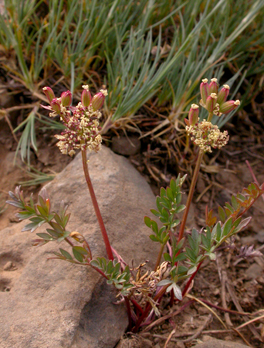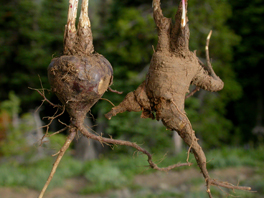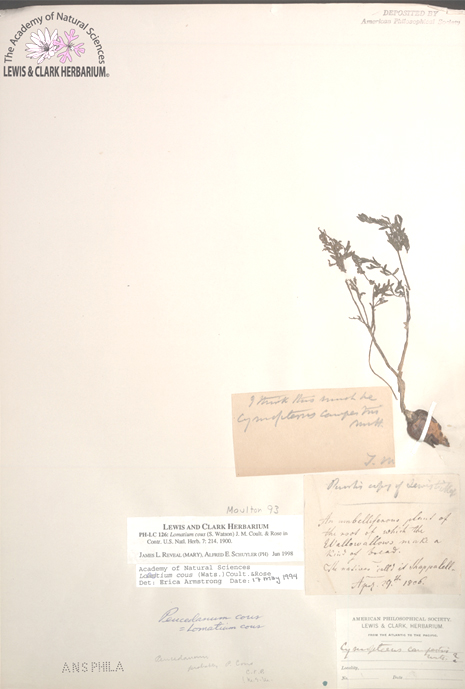William Clark first mentioned the root cous[1]Also called biscuit root and mountain meadow-parsley, it is a member of the carrot family. (pronounced kows)—Lomatium cous from the Greek loma meaning “fringe” or “border,” referring to the winged seed, and cous from the Chinookan informant—on 1 November 1805, saying that native people living near the future Bonneville Dam site traded beads to obtain it from people up the Columbia River. To Clark it was “cha-pel-el bread,” a redundancy in Chinookan languages, because “a-s·blal” meant “bread.” He was reporting its preserved appearance: for storage the roots were pounded, then roasted, and shaped into cakes. In this form, they lasted for years and were light to carry during seasonal migrations and for trading. When boiled in water, the cakes created “a thick soup or mush.”
Meriwether Lewis collected a specimen at the mouth of the Walla Walla River in Washington, 29 April 1806, but whether he traded for it or gathered it himself is uncertain.
Lewis’s specimen
A specimen sheet contains a plant specimen collected in the field and preserved by careful drying between pages of absorbent paper. Although it may not give any hint the beauty of the plant in its living state, the dried specimen preserves all of the other details that are necessary for its identification and classification by scientists who, in Lewis and Clark’s time, were known as “cabinet”—that is, laboratory—botanists. The labels on specimen sheets such as this one trace the abbreviated long-term history of the specimen. The names they bear identify the scientists who have successively reviewed the taxonomy of the specimen (genus, species, subspecies, etc.), beginning with the person who gave it its official name, or protologue.
The following explanations will illuminate the eight numbered labels on this specimen sheet. The tentative nature of some of the labels—”I think,” “probably,” and “?”—reflect the difficulty botanists had for many decades in identifying species in the family Apiaceae. Small wonder. It consists of about 3,500 species worldwide, about sixty of which are found in the Pacific Northwest alone.
1. “T.M.” is Thomas Meehan (1826-1901), a botanist at the Academy of Natural Sciences of Philadelphia who, in 1896, found many of Lewis’s specimens at the American Philosophical Society, where they had lain untouched and forgotten for three-quarters of a century. He persuaded the APS to let him take them to the Academy’s collection, where he could supervise their cataloging and conservation. (Note the stamp in the upper right-hand corner: “Deposited by American Philosophical Society.”) Then he mounted them on fresh specimen sheets, pasted on various labels, including the earliest comments, such as Frederick Pursh‘s of 1806, and in 1898 published the first list of the Lewis and Clark Herbarium.Those specimens remain there on permanent loan. “Nutt” stands for Thomas Nuttall (1786-1859), a pioneering American botanist.
2. “Moulton 93” identifies this specimen as Number 93 in Gary E. Moulton’s Herbarium of the Lewis & Clark Expedition, which is Volume 12 of The Journals of the Lewis & Clark Expedition (see link at the exteme bottom of this page).
3. This is a copy made by Frederick Pursh (1774-1820) of Lewis’s original label. “Umbelliferous” refers to the umbrella-shaped flowers of the species. “Wallowallows” refers to the Walla Wallas, the Indian tribe Lewis and Clark first met on 8 October 1805, and visited again on 27-29 April 1806. Clark told Nicholas Biddle that their chief, Yellepit, was “the greatest we met with.”
4. “Cymopterus” is a combination of the Greek Cym (“waved”) and pterum (“wing”), which more or less describes the fruit, or seed. The genus Cymopterus, which is native to the eastern Mediteranean, is similar to Lomatium, which accounts for Meehan’s conjecture. In fact, both share the common name, biscuitroot. The specific epithet campestris is Latin for “of the plains.”
5. Peucedanum refers to Peucetia, a region in Apulia, which is Italy’s geographical boot-heel. Like Lomatium, the genus Peucedanum belongs to the family Apiaceae, which includes the carrot, parsley, fennel, and caraway. Its species are usually aromatic plants with hollow stems.
“C.V.P.” is Charles Vancouver Piper (1867-1926), a botanist who was instrumental in the rediscovery of Meriwether Lewis’s herbarium, and who also encouraged the publication of the journals of other early botanists who explored the Northwest, such as Archibald Menzies and David Douglas. “M.E.M” was Mildred E. Mathias (1906-1995), a taxonomist and horticulturist with the New York Botanical Garden.
6. The author of this label is unknown.
7. “Wats.” was Sereno Watson (1864-1935), a curator at Harvard. The parentheses around his name indicate that he was not the collector. But the “J.M. Coult” was. John Merle Coulter (1851-1928) was head of the botany department at the University of Chicago. “Rose” was Joseph Nelson Rose (1862-1928), of the Smithsonian Institution, who was an authority on plants of the family Apiaceae. “Det.” is the abbreviation for “determined by,” signifying that the identity of the specimen and the history of its taxonomy have been reviewed and confirmed by Erica Armstrong, a botanist who worked at the Academy in the early 1990s.
8. This is the official label of the Lewis and Clark Herbarium (“LC”) at The Academy of Natural Sciences of Philadelphia (“PH”); the number of this specimen in the herbarium is “126.” Coult and Rose dealt with this plant in Volume 7 (1900) of Contributions from the United States National Herbarium.
Primary Source
A. Scott Earle and James L. Reveal, Lewis and Clark’s Green World: The Expedition and Its Plants, Helena, MT: Farcountry Press, 2003.
Notes
| ↑1 | Also called biscuit root and mountain meadow-parsley, it is a member of the carrot family. |
|---|
Experience the Lewis and Clark Trail
The Lewis and Clark Trail Experience—our sister site at lewisandclark.travel—connects the world to people and places on the Lewis and Clark Trail.
Discover More
- The Lewis and Clark Expedition: Day by Day by Gary E. Moulton (University of Nebraska Press, 2018). The story in prose, 14 May 1804–23 September 1806.
- The Lewis and Clark Journals: An American Epic of Discovery (abridged) by Gary E. Moulton (University of Nebraska Press, 2003). Selected journal excerpts, 14 May 1804–23 September 1806.
- The Lewis and Clark Journals. by Gary E. Moulton (University of Nebraska Press, 1983–2001). The complete story in 13 volumes.




